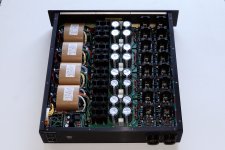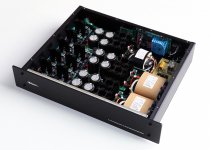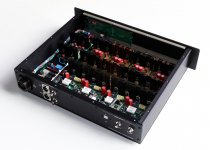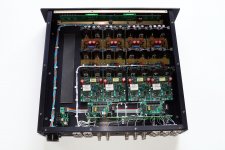Your logic is just different from the common people. My training in engineering and many years of practicing allows me to apply logic properly and still accept the intangible.I am ok with the lack of knowledge, but the lack of logic really puts me off. Best of luck.
I do not accept your logic of expensive capacitor must be better.
I order 20 pieces of the Elna SILMIC II from Digikey. ...
It is going into the 3 Sherwood S-6040CP power amplifier for the input cap.
The S-6040CP has a JFet complementary differential input stage; it doesn't need an input cap.
I do not accept your logic of expensive capacitor must be better.
Please stop putting words in my mouth. Where did i write this? Where did i write about the Sony amp being better? Childish insinuations.
It does vary in time 200 to 400 hours according to most subjectivists like myself. There is definately a subjective difference in sound after several hundred hours. Better in case of Nichicons but worse on the Similacs I've heard. It would be interesting to see some meausrements though. Mabye test after 500 hours just to be on safe side of break in.Has anyone ever successfully measured break-in in capacitors? That would finally prove to subjectivists that measurements are useful and make objectivists eat humble pie
it doesn't need an input cap.
The only reason for this cap would be a dc coupled source as in this circuit the DC gain = AC gain and the protection circuit may start triggering quite often .
There is definately a subjective difference in sound
Not arguing with that, just saying this will not skew the distortion measurements as it has no effect on harmonic distortion. There is no known method to objectively test for break in.
OK that makes sense but would be good just to have it verified by testing.Not arguing with that, just saying this will not skew the distortion measurements as it has no effect on harmonic distortion. There is no known method to objectively test for break in.
Yes, the S-6040CP does not need an input cap. Over the years, the DC offset is always small at the output. Inkel put the cap there to eliminate the offset from whatever is upstream of it.The S-6040CP has a JFet complementary differential input stage; it doesn't need an input cap.
In my case, I should not need it either because my preamplifier is servo controlled too. But I like to keep the input cap there to protect it from unexpected power line disturbrance. I leave my audio on 24/7.
It does vary in time 200 to 400 hours according to most subjectivists like myself. There is definately a subjective difference in sound after several hundred hours. Better in case of Nichicons but worse on the Similacs I've heard. It would be interesting to see some meausrements though. Mabye test after 500 hours just to be on safe side of break in.
No electronic component needs breaking in, that's audiophile mythology.
What you are experiencing is a psychological response.
The above differences in opinion remind me of the arguments between JLH and D.Self in WW&EW circa 1980,s on .
As a JLH follower as well as watching the difference of -noise etc on my TEX. scope I found that JLH had a point as regards the makeup of various types of capacitors .
He was backed up by a capacitor design engineer who went to great length using high power maths and test experience to prove JLH had a point .
He designed an audio oscillator with cutting edge diminishing amounts of distortion over several issues of the mag even designing a jig to measure the said capacitors that were tested on it .
Without coming out loud about it he proved by actual engineering that JLH was right and used expensive trade capacitors/resistors to build the unit .
Too much of a big job for me being a bit lazy especially as the time involved would be long.
The arguments did not endear me to D.self as John was too much of a gentleman to reply in kind.
As a JLH follower as well as watching the difference of -noise etc on my TEX. scope I found that JLH had a point as regards the makeup of various types of capacitors .
He was backed up by a capacitor design engineer who went to great length using high power maths and test experience to prove JLH had a point .
He designed an audio oscillator with cutting edge diminishing amounts of distortion over several issues of the mag even designing a jig to measure the said capacitors that were tested on it .
Without coming out loud about it he proved by actual engineering that JLH was right and used expensive trade capacitors/resistors to build the unit .
Too much of a big job for me being a bit lazy especially as the time involved would be long.
The arguments did not endear me to D.self as John was too much of a gentleman to reply in kind.
@analog_sa:
Douglas Self published an article about this some years ago in Linear Audio. It did prove that distortion drops over time in an electrolytic capacitor. Not much but measureable.
Best regards,
Jesper
Has anyone ever successfully measured break-in in capacitors? That would finally prove to subjectivists that measurements are useful and make objectivists eat humble pie
Douglas Self published an article about this some years ago in Linear Audio. It did prove that distortion drops over time in an electrolytic capacitor. Not much but measureable.
Best regards,
Jesper
No electronic component needs breaking in, that's audiophile mythology.
What you are experiencing is a psychological response.
Sorry but I experienced this myself very often with BG caps. These really needed the time.
@analog_sa:
Douglas Self published an article about this some years ago in Linear Audio. It did prove that distortion drops over time in an electrolytic capacitor. Not much but measureable.
Do you happen to remember over what period of time? Were a significant number of capacitors tested? Sample to sample variations could swamp the results.
A difference over several hours seems very plausible as the caps need some time to fully form. It would be interesting to compare the 20h to the 200h distortion. Afaik there has never been a proof of distortion changing over a long period of time but i can certainly be wrong.
Build a paradise phono stage, and measure dc offset at the output. It takes about 70 hours at first switch on for it to drop to the minimum level as the lytics form on the current mirrors and leakage stabilised. It takes so long because of the tiny current flowing.
But surely people arent arguing over the existence of lytic capacitor forming? Surely break in is another mystical thing altogether.
But surely people arent arguing over the existence of lytic capacitor forming? Surely break in is another mystical thing altogether.
Maybe forming = breaking in?
I build a lot of stuff and spend less and less time on forums but I have very often experienced devices to sound plain when powered up first. After a few hours they sounded better, certainly with BG caps. Since I like quality stuff I tend to destroy mediocre sounding DIY devices and more than once I was on the verge of deciding to recycle a newly built device. Patience turned out to be a virtue
I build a lot of stuff and spend less and less time on forums but I have very often experienced devices to sound plain when powered up first. After a few hours they sounded better, certainly with BG caps. Since I like quality stuff I tend to destroy mediocre sounding DIY devices and more than once I was on the verge of deciding to recycle a newly built device. Patience turned out to be a virtue
Last edited:
Maybe forming = breaking in?
I have built a number of 0.1-10 Hz low noise amplifiers, to measure noise from voltage references among other things. At the input you need a 1000-3300 uF capacitor with very low leakage. This has resulted in me making a large numbers of leakage measurements, and all electrolytic caps takes days to get down to the desired/final leakage levels (<5nA @ 7-10V). Some of the bad ones never goes below 1uA. Best result with Al caps was Panasonic FM @ 2nA, wet tantalum (TWA-E) hit 450 pA. Solen PP 100 uF settles in <30s for comparison (@ 3pA). Higher rated voltage is correlated with lower leakage, given the same VW @ 7-10V.
If 'lytics are formed an hour at rated voltage (charging ramp 1 mA), they then settle their leakage current somewhat faster afterwards.
So, if leakage current is related to burn-in, there is a measureable process that takes some time. I havent measured DA but there is a chance it also changes during initial use.
@analog_sa: I just took a look at Self's article and my memory was off: The measurements were not made on electrolytic capacitors but polyester capacitors (linear audio volume 1). Distortion drop was from 0,0008% to 0,0004%, and fell a bit more afterwards. Test time was 11.1 hours.
Cheers,
Jesper M
Cheers,
Jesper M
Has anyone ever successfully measured break-in in capacitors? That would finally prove to subjectivists that measurements are useful and make objectivists eat humble pie
why? what for? if you want to break in your caps, go ahead and just do it....
Me too. And although i am generally not a teflon fan - this includes cabling too - i find the ex-Soviet caps much worse than any other teflon caps. They just kill dynamics and tonality but also remove sharp edges and make low quality sources more palatable.
Did you take the steel cans off?
Caps can be audibley different in some cases where they are taxed, like speaker crossovers and maybe feedback networks but the audiophool belief that same spec caps are audibley different in most circuits is BS. If its true you should be able to prove it and explain the physics.[/QUOTE]
I don’t have to prove anything to you and who said everything could be explained by physics? Does chemical analysis explain the difference between Scotches, or a Picasso and Renoir painting of a woman? Matter of preference, budget, value, and hearing sensitivities. Save the money if you can't hear it, but don’t deride those who do and are willing to pay for it. The site is for sharing opinion, experience, and research.
My system is totally direct coupled discrete Class A jfet/fet fully balanced design up to the full range ESL. it does have 16 fet shunt regulators with Jung Super regulators as pre regulators , which use electrolytics. They use Monty McGuire’s suggestion for a servo opamp of very low noise. Heres the dac and line stage and thier power supplies, designed by Erno Borbely, boards by me, and assembly by Les Bordelon. Now show me something you’ve built that would convince me you could hear the difference.
I don’t have to prove anything to you and who said everything could be explained by physics? Does chemical analysis explain the difference between Scotches, or a Picasso and Renoir painting of a woman? Matter of preference, budget, value, and hearing sensitivities. Save the money if you can't hear it, but don’t deride those who do and are willing to pay for it. The site is for sharing opinion, experience, and research.
My system is totally direct coupled discrete Class A jfet/fet fully balanced design up to the full range ESL. it does have 16 fet shunt regulators with Jung Super regulators as pre regulators , which use electrolytics. They use Monty McGuire’s suggestion for a servo opamp of very low noise. Heres the dac and line stage and thier power supplies, designed by Erno Borbely, boards by me, and assembly by Les Bordelon. Now show me something you’ve built that would convince me you could hear the difference.
Attachments
Last edited:
- Home
- Design & Build
- Parts
- Best electrolytic capacitors



